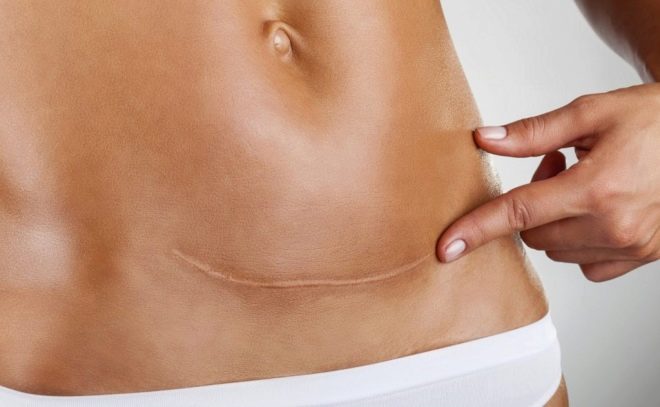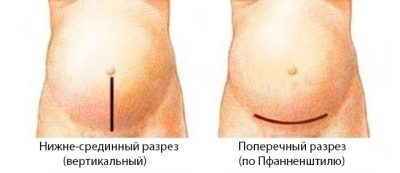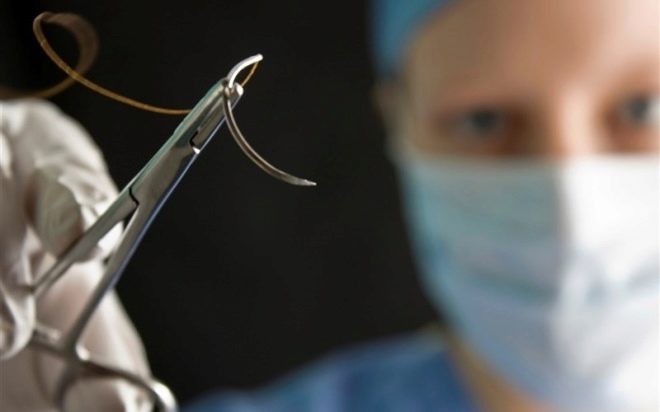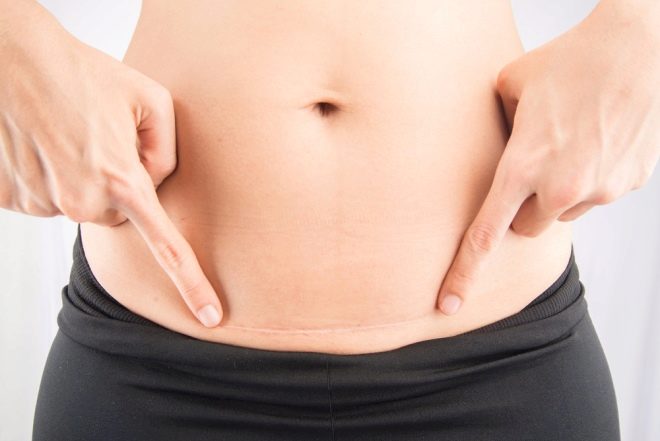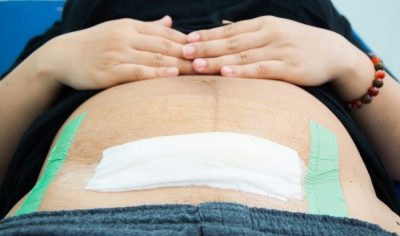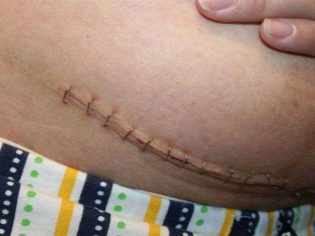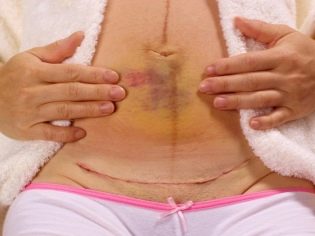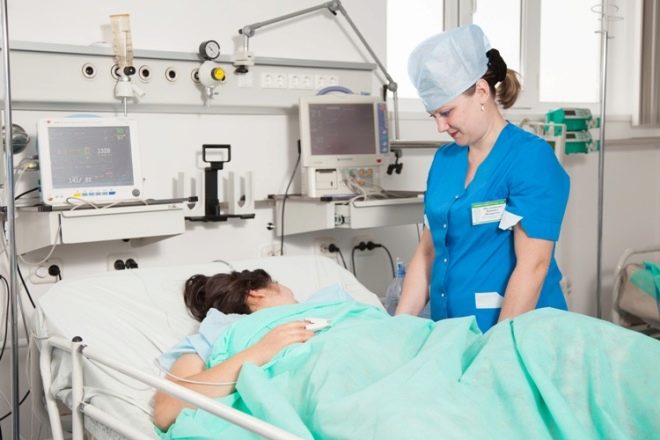On which day after cesarean section do stitches be removed and is this procedure painful?
If the future mother's state of health does not allow her to give birth on her own, doctors do a cesarean section. Such an operation is not an easy test for a woman, because in her process, the tissue is cut and then stitched. To heal normally and without any complications, you should carefully monitor the seams.
Many women who have undergone a cesarean section or are expecting such an operation are also interested in the day on which the stitches are removed, whether the procedure is painful.
Features of the operation
As you know, to extract a child with a caesarean section, an abdominal incision is needed, which cuts the skin of the abdomen and subcutaneous adipose tissue, as well as other connective tissue. If there are no problems in the process of childbirth and the intervention is planned, such a cut is made transversely over the pubis in the form of an arc, without affecting the abdominal cavity. The scar after it heals faster and often barely noticeable, and the suture is called cosmetic.
If the operation is performed urgently or during delivery there are difficulties (for example, bleeding), then doctors use a longitudinal incision that starts from the navel and reaches the pubis. Its healing is longer, and the seam formed after such an incision is more noticeable and does not look very aesthetically pleasing.
After dissection of the tissue of the abdominal wall, physicians perform an incision in the uterus. Its direction may coincide with the first incision, which cut through the skin, but sometimes it is different, for example, after a vertical external incision, the uterus is dissected transversely, and after an arched incision of the skin above the pubis, the uterus can be cut vertically.
As soon as the baby is removed from the uterus, doctors begin to stitch internal sutures. Their goal is faster healing of the tissues of this organ and reduction of blood loss. For the imposition of such seams apply several techniques (both manual and hardware), the necessary of which the doctor selects individually.
How long do sutures heal when removed?
The healing time is affected by the type of incision and the suture itself, which was performed during the operation.
When the cosmetic seam, which is now the most common, used threads that can eventually dissolve on their own. This means that there is no need to remove such seams. A woman with a cosmetic seam is discharged home without any additional procedures. Usually, threads disappear completely by 60-80 days after cesarean section.
If the incision was vertical, then more dense materials are used for the suture, which should be removed as it heals. This procedure is carried out not earlier than the fifth or seventh day after surgery. It only takes a few minutes and is a bit uncomfortable, but not painful at all. First, the doctor cuts off the ends of the suture, on which there are knots, then gently removes the thread. Anesthesia for the removal of sutures is not used.
Before a woman leaves the maternity hospital, the condition of internal sutures is also checked. To do this, use ultrasound, which shows the degree of healing, well whether the uterus is reduced. If any problems are found on the ultrasound, the discharge is postponed and treatment is prescribed.
How to care?
Special care external cosmetic seams after cesarean do not require, provided that the healing is normal.Antiseptics can be used for processing, but often the suture is closed immediately after the operation with a special tight bandage. It is sealed, helps the seam to "hold" and reduces pain. In addition, you can take a shower with her after the woman is transferred to a regular room. This bandage is usually removed for 5-6 days.
At home, the seam is often not required to powder or lubricate, but treatment with iodine, brilliant green or other antiseptics is permissible. In addition, it is important to pay attention to such nuances:
- the seam should not be injured by underwear or clothing, therefore it is recommended to wear high panties made of natural fabric;
- to eliminate the discrepancy, the mother should not lift weights or play sports for at least 1.5-2 months after cesarean;
- during the shower, the seam should be washed only with hands, without the use of a washcloth;
- wipe your skin after a shower is recommended with a soft cloth with pro-wipe movements;
- the seam should "breathe", so you can not glue it with a plaster;
- you can wear a bandage, as it will support the stomach and promote healing;
- It is important to adjust the food of the mother so that the problems with the work of the intestines do not disturb the seams.
If there are no complications, then 14 days after the operation, you can start using products that promote skin regeneration.
Possible complications
In some women, a problem with stitches may occur even in the hospital. These include seam discrepancy or bleeding from it, as well as inflammation of the sewn area with suppuration. These early complications can occur due to poor care, weight lifting, careless replacement of the dressing, or too early removal of the thread. In such situations, doctors do some processing and provide the help they need depending on the problem. Consider separately the complications that may appear at home.
- The seam can disperse due to active movement and heavy physical exertion. To prevent this from happening, after a cesarean for some time you should not lift heavy objects that weigh more than a baby.
- Because of the ingress of bacteria into the postoperative wound, the suture may become festering. This is manifested by swelling, redness and other visible skin changes. In such a situation, the use of local antibacterial agents and antiseptics is shown.
- Due to the suture rejection, fistulas may occur at the suture site. Edema, tenderness and redness of the postoperative scar will tell about their appearance, after which the fistula breaks through, and the woman notices the discharge. Independently eliminate such a problem will not work, so if you have a fistula, you need to consult a doctor.
- Due to improper healing, a keloid scar can form. Unlike fistulas and other complications, it is only an aesthetic problem and does not harm health in any way. Its cause is the uneven growth of tissues in the postoperative wound, as a result of which the scar becomes dense and wide. To eliminate keloid, special ointments and creams are used, as well as ultrasound, laser or liquid nitrogen, but it is often necessary to resort to surgical excision of overgrown tissues.
With regard to pain in the seam, the woman should understand when the postoperative scar can hurt and this is normal, and when you need to see a doctor as soon as possible.
Immediately after surgery, there is usually no pain, as anesthesia continues to function. But after a few hours, the entire stomach in the lower region starts to hurt with any movements. This is an absolutely natural reaction, therefore, women undergoing cesarean section are prescribed effective analgesics.
The pain is also normal for 2-6 days after surgery. They are due to the contraction of the uterus and the tension of the abdominal muscles. If pains in the area of the suture appeared after some time (for example, after 2 weeks or a month), this may be a manifestation of various complications, including endometritis, hematoma, suppuration, adhesions and other problems.
Therefore, when discomfort and painful sensations that have arisen after discharge, it is recommended to consult a doctor.
More information about the care of stitches after surgery can be found in the following video.

